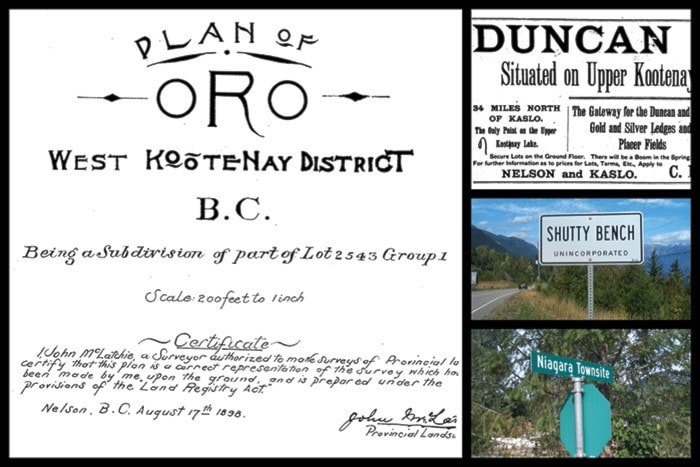By Greg Nesteroff
First in a series
How do places get their names? In many different ways. In West Kootenay Boundary, names were bestowed when a townsite was staked, a railway was pushed through, steamboat service commenced, or a post office opened. Often the names were after early settlers, CPR officials, mines, or geographic features. Some were named after other places, some to inspire settlement, and others to honour prominent people who may never have actually visited.
Of course, many of these same places already had First Nations names. Not many are still in use, but the ones that are — Kootenay, Kokanee, Slocan, Nakusp, and possibly Kaslo — are among the most intriguing on the local map. One subset of names unique to this area are those given by the Doukhobors, although only two — Ootischenia and Krestova — remain in widespread use.
Many place names have multiple, contradictory theories explaining their origins.
In Devious Derivations, Hugh Rawson writes: “People cannot resist making up explanations for the origins of words and phrases. Their theories are at once a reflection of the general reluctance to accept uncertainty and a tribute to their powers of creativity.”
The same is certainly true for place names, or toponyms, as they are otherwise known.
Some names have no wholly satisfying explanation — Howser and Wynndel chief among them. However, that doesn’t mean we will never find the answers.
For more than a century the true origin of Castlegar eluded local historians until the mystery was finally solved in 2002: it’s the Irish ancestral home of the townsite’s founder.
Many places had multiple names, often the result of competing railways. Sometimes the same place had one name for the post office and another for the railway siding. The settlements along Highway 31A between New Denver and Kaslo — known as the Valley of the Ghosts — were especially prone to this: Retallack, Nashton, and Sproule’s each had five other names.
Each week this column will examine one or more local place names, providing its first known use, previous names, post office history, and some commentary on its derivation. Not all will be included, but neither will the obscure ones be ignored.
We’ll proceed alphabetically and begin next week with a community that starts with A and is also West Kootenay’s oldest still-inhabited settlement.
Readers so inclined can refer to several books on the subject: British Columbia Place Names, by G.P.V. and Helen Akrigg, went through three editions (and contains a much more thorough discussion on what they call the “historical stratigraphy” of names), while Mark Thorburn wrote a more recent volume with the same title.
Alistair Fraser’s Kootenay Lake website also devotes a page to the subject at http://kootenay-lake.ca/geography/toponymy/index.html
